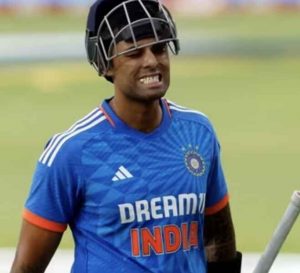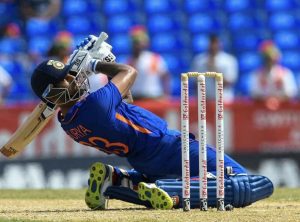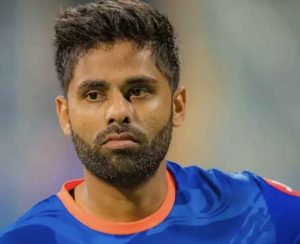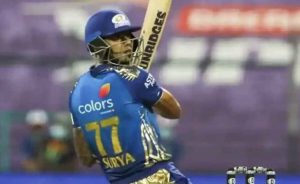Because of an ankle injury he suffered during the T20I series against South Africa, cricketer Suryakumar Yadav, who currently leads the T20I batting rankings, has been left out of India’s T20I squad against Afghanistan.
But according to recent Times of India reports, Suryakumar had surgery in Munich, Germany, after receiving a sports hernia diagnosis. He is recuperating at the National Cricket Academy in Bengaluru, and a source close to the Board of Control for Cricket in India (BCCI) has confirmed that he will be flying to Germany for the procedure in the coming days.
Cricketer Suryakumar Yadav injury:

The Times of India cited a Board of Control for Cricket in India (BCCI) source as saying, “SKY was diagnosed with a sports hernia recently. At Bengaluru’s National Cricket Academy, he is currently recovering. He is scheduled to travel to Munich, Germany in two to three days for surgery. It means that he certainly won’t be playing for Mumbai this season in the Ranji Trophy and is likely to miss the initial games for the Mumbai Indians in the IPL.”
What is a sports hernia?

For those who are unaware, an athletic Pubalgia, commonly referred to as a sports hernia, is a painful soft tissue injury that affects the groyne region. A sports hernia is characterised by a strain or tear in the muscles, tendons, or ligaments of the lower abdomen and groyne area, as opposed to a traditional hernia, which is characterised by a hole or weakness in the abdominal wall. Athletes who play sports requiring abrupt direction changes, twisting motions, or repetitive strain on the pelvic region are susceptible to this injury.
Sports hernias are more likely to happen in physically demanding sports like ice hockey, football, soccer and wrestling because these activities frequently involve twisting the pelvis with planted feet. According to WebMD, “this action may result in the tearing of the soft tissue in the lower abdomen or groyne.”
Doctor’s opinion on Sports Hernia:
Dr. Somyaa Khuller, a general surgery consultant at Sakra World Hospital, stated in an interview with HT Lifestyle that an athletic Pubalgia, also known as a sports hernia, is a pain syndrome affecting the lower abdomen and groyne. He stated, “It typically happens when a strain or tear in soft tissue, such as muscles, tendons, or ligaments, damages a muscle or tendon in the lower abdomen or groyne. Repetitive, violent pelvic twisting—a common occurrence in sports like football, hockey, soccer, skiing, and ice skating—is a common cause of the condition. Seldom can it also happen to people who don’t play sports.”

She shared that the signs and symptoms include severe abdominal pain, especially in the groyne area, and chronic pain. She also mentioned that the condition is frequently misdiagnosed as an inguinal hernia and that a clinical evaluation and thorough investigation are necessary before treatment can be planned. The doctor added, “Sports hernia recovery times vary depending on the location, severity, and type of treatment used. When given enough rest and physical therapy—which is crucial to the healing process—mild cases can recover in about 8 weeks, but more serious cases or those that require surgery may need a longer recovery period, usually lasting 6 to 12 weeks.”
Causes:
- Repetitive Motions: Repetitive motions, like those found in sports like football, hockey, tennis, and soccer, can lead to sports hernias. Sports hernias can occur from activities that require cutting, pivoting, or abrupt changes in direction.
- Weakness or Imbalance: The risk of a sports hernia can be raised by weakness or imbalance in the muscles that surround the pelvis and lower abdomen. Muscle imbalances, inadequate strength training, or poor conditioning could be the cause of this.
Symptoms:
- Groin Pain: Usually, groin pain that is dull, sharp, or persistent is the main symptom. Certain movements, like twisting or turning, may make the pain worse.
- Tenderness: Sensitivity or tenderness in the pubic area or lower abdomen.
- Pain during Activities: Certain activities can cause pain, particularly those that require abrupt direction changes or strong contractions of the abdominal muscles.
- Swelling: Some people might get swelling in their groyne region.
Remedies:
- Ice and rest: For the injured tissues to heal, rest is essential. Ice can help ease pain and reduce inflammation. In the early days following an injury, applying an ice pack to the injured area for 15 to 20 minutes every few hours may be helpful.
- Physical Medicine: A well-designed physical therapy programme can help address any muscle imbalances, increase flexibility, and strengthen the muscles surrounding the injured area. Exercises for strengthening, stretching, and core stability can all be considered therapeutic.
- Medicines that Reduce Inflammation: Ibuprofen is one example of a nonsteroidal anti-inflammatory drug (NSAID) that may help lessen pain and inflammation. However, prior to taking any medication, it is imperative that you speak with a healthcare provider.
- Assistive Technology: Wearing a supportive brace or belt to stabilise the injured area during physical activity may be beneficial for certain individuals.
- Operation: Surgical intervention may be considered in severe cases or in cases where conservative measures are unsuccessful. The goal of surgery is to restore the groyne area’s torn or damaged tissues.
It’s critical to speak with a medical expert, such as an orthopaedic physician or sports medicine specialist, to receive a precise diagnosis and a treatment plan that is customised for your particular situation.
Back to Suryakumar:

While Suryakumar Yadav is recuperating at the National Cricket Academy in Bengaluru, he will be travelling to Germany in the coming days for sports hernia surgery, according to a source within the Board of Control for Cricket in India (BCCI). Due to a sports hernia, Suryakumar was ruled out of the T20I squad against Afghanistan.
His condition was made public following an ankle injury sustained during the South Africa T20I series. This health setback has now raised awareness of the complexities of sports hernias, their prevalence in the sport, and how athletes manage treatment and recovery.
So, this was all about the ace cricketer Suryakumar Yadav. Also read, Singer Shubh cryptic reply to cricketer Virat Kohli

